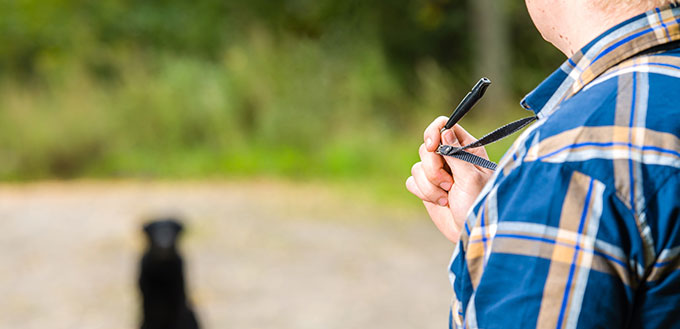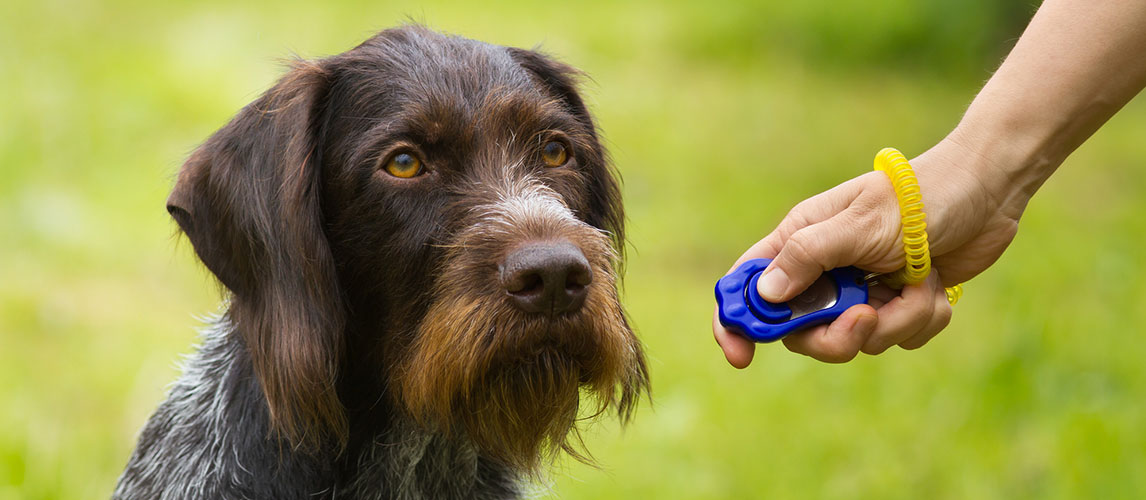Dog training is not optional! As soon as you bring your pooch back home, you need to introduce a dog training regime to prevent behavioral problems from creeping in and making life difficult. There are several approaches to dog training and each owner has their favorite but many choose to use a whistle. These handy devices have been around for hundreds of years and are a great way of getting your dog’s attention. Not everyone likes them and they are not a quick fix for training your dog – you still have to put the effort in. Nevertheless, when used correctly, a whistle can be an excellent tool to train your dog.
What Makes a Whistle Great for Dog Training?
If you are still not sure if whistle training is for you, here are some compelling reasons why a whistle is such a great training tool for your dog.
- They can be heard from a long way away!
Dog whistles were first used for training herding dogs when the shepherds were a distance away from them. Even if you are able to shout very loud, you may not want to do this in your local street or park! And if you are able to overcome the embarrassment, the human voice can only carry so far. A whistle, on the other hand, can be heard from at least 200 yards away. You will be able to get your dog’s attention even if they are running away from you! Also, the distinctive and high-pitched tone can be picked up very easily by a dog’s hearing. It will stand out amongst the noise of traffic and people talking.
- They make a consistent noise
A dog will learn best when there is consistency in the training approach. It can be hard to achieve this with your voice. Also, if more than one of you is training your dog, your voices will inevitably sound different and this can be confusing. The same is true for hand signals. We all tend to use our own variation of them and this can be problematic.
A whistle is a useful training tool because it will always sound the same, no matter how it is blown or who is blowing it! The whole family can join in with the process but you can maintain consistency.
- They can kick start a failed training regime
It is not at all uncommon for dog owners to lose their way a bit with training. You may let things slide and allow behavior to creep in that you are not really happy with. It can be hard to turn this situation around without using a new approach and a dog whistle can be that approach.
You can actually teach an old dog new tricks if you use a whistle to have a fresh start. The unique whistle noise will immediately get your dog’s attention and you can start your training all over again with renewed enthusiasm.
Of course, you can also use whistle training with a new pup and they will get the hang of it right away.
How to Choose a Dog Whistle
There will be plenty of whistles to choose from and it is quite likely that you will need more than one. You will probably want one at home, one in your car and perhaps one in your coat pocket! Here are the main variations that you will find.
- Material
A dog whistle can be made from metal, plastic, or wood. Whilst wood may be the eco-friendly whistle choice, the strongest whistles are made from metal and these would be the best choice for dog training. A plastic dog whistle is likely to be flimsy and could get broken when it is hanging around your house or when you are out and about.
The whistle should be easy to clean and you may want to attach it to a key fob or chain around your neck where you can reach it quickly.
- Frequency Range
It doesn’t really matter what frequency range you choose but you must stick to it! Changes in whistle frequency will cause great confusion to your dog so if you have several whistles, make sure that they are the same frequency!
The same applies when you buy a replacement whistle. As soon as your new whistle arrives, write down the frequency somewhere safe!
You could use a silent dog whistle because dogs can hear frequencies that the human ear cannot detect. However, this may not be the best whistle for you. It will be much easier for you to produce a consistent whistle blast if you can hear it yourself as you train your dog.
When to Use Your Dog Whistle
Dog whistles offer a lot of flexibility when it comes to training commands. You can use your whistle to teach your dog the basics. These include sit and recall which are both quite straightforward and are a good place to start. Of course, you can make up your own whistle commands for these but you could also adopt the established patterns that have been used by generations of dog trainers and shepherds. Once you have mastered the basics, you can teach your pooch more complex commands such as go left, go right, lie down and roll over.
When training a working dog, you may want to introduce more complex commands to get them to do specific tasks and these will need a distinct whistle pattern.
Before you start, have a go at using the whistle yourself. Experiment with blowing into it until you can make a consistent sound that is strong and does not waver or change pitch at the start or at the end. To do this correctly, you will need to use your tongue to stop the air suddenly and bring the sound to a neat stop without trailing off. This is done by touching the tip of your tongue at the mouthpiece as if you are making a ‘T’ noise.
Using Your Whistle for the Sit and Recall Commands
Most dog care manuals and dog behavior experts will recommend that you start off by training your pooch to sit using a verbal ‘sit’ command. This is a good way to help your dog learn that they must pay attention to you and do what you tell them. It is also a good way of disrupting unwanted behavior and bringing your dog back under control.
Recall is another important command and another time when you should use your whistle, especially as you are likely to be outdoors where it is harder for your dog to hear verbal commands and where there are a lot of distractions for your pooch.
Most trainers use one short blow of the whistle as a sit command. It is a very easy sound for your dog to recognize and will get their attention quickly. Also, it is the most common command that you are likely to use and so it is a good idea to keep it as simple as possible.
The recall command needs to be approached differently. When you use it, your dog will probably be some distance away from you. Perhaps they will be barking at another dog or at a small mammal in the undergrowth. This will make it harder for them to hear you so you will need to blow the whistle for a longer period. Many trainers use three short whistle blows for this command.
Getting Your Dog to Listen
As with all dog training, this is going to require a lot of patience and some tasty treats! The fundamental principle is that you reward your dog with a treat when they obey a command and that makes them want to obey you in the future. They will associate doing what they are told with getting a treat and that is definitely something that your dog will want to aim for! This is positive reinforcement and is much better than scolding them for doing something wrong which is a negative approach and does not work as well. Find out more about Dog Treats here.
If you are starting whistle training with a new pup, you could start off using just whistle commands. However, this can be hard work and a young dog can take some time to get used to it. The best approach may be to teach your dog some voice commands first and then progress to whistle commands. You simply add on the whistle command as you use the verbal instructions.
Teaching the ‘Sit’ Command
The important thing here is to blow the whistle after your dog has sat down and not before. The best way to achieve this is to hold a treat right above your dog’s head. As they look up to gaze at the treat, their butt naturally lowers to the floor. As soon as their body makes contact with the ground, blow the whistle and give them the treat. Most dogs get the hang of this within a week or so.
Teaching the ‘Recall’ Command
It is best to start this training indoors and in a room where there are no distractions. Ignore your pooch for a couple of minutes and then blow the dog whistle command (and give the verbal command if your dog already knows it). Inevitably, your pooch will come over to investigate the noise and you should give them a treat and a lot of fuss.
Repeat this another couple of times and then forget about it for the rest of the day. Try it again the following day and in time, your dog pooch will associate that whistle command with a tasty treat. It will then be time to try it out in the open air. You may want to use a long leash to begin with just in case your pup bolts and refuses to come back.
The Last Word on Whistles…
Dog whistles are a great way to control unwanted behavior and to keep your pooch under control. They are more consistent than voice commands and they allow all members of the family to get involved with training. Once your pooch gets the hang of it, you can introduce more complex commands and really show off!
Sources:
- Simon Foden, How to Use a Dog Whistle to Prevent Bad Behaviors, The Nest
- Hannah Harris, How Dog Training Works, HowStuffWorks








